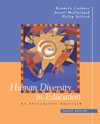 |
1 |  | 
Two physical criteria used to define one's racial identity are: |
|  | A) | Skin color and shared language |
|  | B) | Skin color and facial features |
|  | C) | Customs and shared language |
|  | D) | Skin color and shared history |
 |
 |
2 |  | 
In an adaptation of Cross's racial identity model, Spring proposes that an individual goes through the following five stages as he/she internalizes a positive Black identity: |
|  | A) | Birth, sensorimotor, preoperational, concrete operational, and formal operational |
|  | B) | Trust versus mistrust, industry versus inferiority, identity versus role confusion, and intimacy versus isolation |
|  | C) | Pre-encounter, encounter, immersion-emersion, immersion and internalization |
|  | D) | Ethnic psychological captivity, ethnic encapsulation, ethnic identity clarification, multiethnicity |
 |
 |
3 |  | 
In Banks's model of ethnic development, when individuals are in the globalism stage: |
|  | A) | They are able to clarify their own cultural identity. |
|  | B) | They reflect positive ethnic, national, and global identities. |
|  | C) | They are engaged in global economic activities. |
|  | D) | They are less than happy about the new global economy. |
 |
 |
4 |  | 
Schools are good places to begin progress toward the goal of developing global competencies because: |
|  | A) | Students of many different backgrounds are likely to be found there. |
|  | B) | Teachers want to be members of a global community. |
|  | C) | School boards believe such competencies will help them pass levies. |
|  | D) | Principals and parents are enthusiastic about such goals. |
 |
 |
5 |  | 
One argument for instituting multicultural education programs is: |
|  | A) | There is funding for them. |
|  | B) | The melting pot didn't work. |
|  | C) | All teachers are enthusiastic about them. |
|  | D) | The government insists that they be implemented. |
 |
 |
6 |  | 
Multicultural education programs that focus on communication and self-esteem are categorized by Sleeter and Grant as: |
|  | A) | inclusive multicultural education |
|  | B) | education that is multicultural and social reconstructionist |
|  | C) | human relations |
|  | D) | teaching the culturally different |
 |
 |
7 |  | 
In the Mitchell Typology, models of cultural competence focus on all of the following, except: |
|  | A) | They promote appreciation of other groups. |
|  | B) | They do not focus on one's own cultural identity. |
|  | C) | They assert that all students should be "at home" in more than one cultural group. |
|  | D) | They insist that members of minority groups be fluent in the dominant culture. |
 |
 |
8 |  | 
Which of the following is not a skill associated with intercultural competence? |
|  | A) | the ability to respond to others in a nonjudgmental way |
|  | B) | the ability to propose more than one interpretation of behavior |
|  | C) | the ability to learn a second language |
|  | D) | the ability to promote effective intercultural interaction |
 |
 |
9 |  | 
Which of the following characteristics reflects the DMIS stage of Defense? |
|  | A) | inability to see cultural differences |
|  | B) | ability to recognize cultural differences but denigration of most |
|  | C) | acceptance of superficial cultural differences |
|  | D) | ability to recognize and accept cultural differences on their own terms |
 |
 |
10 |  | 
The following statements describe Acceptance, the first of the ethnorelative stages of the DMIS, except: |
|  | A) | Acceptance represents an individual's ability to interpret phenomena within a cultural context. |
|  | B) | Acceptance represents an individual's ability to analyze interactions in culture-contrast terms. |
|  | C) | Acceptance represents an individual's ability to seek out cultural difference. |
|  | D) | Acceptance represents an individual's ability to accept, respond, and agree with cultural differences. |
 |



 2003 McGraw-Hill Higher Education
2003 McGraw-Hill Higher Education